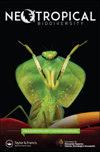厄瓜多尔沿海海洋初级生产趋势模式
IF 0.8
Q4 ECOLOGY
引用次数: 3
摘要
初级生产力(Primary productivity, PP)是由光自养生物通过光合作用将无机碳转化为有机宏量营养素和微量营养素的重要海洋过程。虽然原位研究已经揭示了叶绿素a (Chl a)浓度的空间和季节变化,从而揭示了特定研究地点的PP,但在厄瓜多尔沿海更广泛的地区,没有全面的监测方案来评估其长期变化及其季节模式。本研究的主要目的是评估厄瓜多尔沿海Chl - a浓度的变化,并检查这些变化如何对应于海表温度(SST)的变化。利用MODIS-Aqua和MUR的卫星测量,对厄瓜多尔沿海的18个近海和近岸采样点进行了15年的研究。结果表明,与其他海洋地区相比,厄瓜多尔沿海地区的平均Chl - a浓度相当低(1.5 mg m - 3)。玻利瓦尔港、瓜亚基尔湾和埃斯梅拉达斯的Chl - a平均浓度最高;而Galera San Francisco Marine Reserve, Cojimies和cabyal的特征是最低的。在最南端(玻利瓦尔港和瓜亚基尔湾)和最北端(埃斯梅拉达斯)的研究地点,Chl - A浓度呈上升趋势,其季节性趋势与观测到的季节性海温趋势一致。洪堡上升流系统和河流流量共同影响的地区Chl a较高。Chl a与海温的正相关可能是对温暖月份降水增加的响应。这些结果强调了提高我们对气候变化对沿海PP影响的理解的重要性,以及这些影响对商业和受威胁海洋物种健康的潜在影响。进一步的研究应评估PP和SST变化对厄瓜多尔沿海具有商业和保护意义的物种的影响。本文章由计算机程序翻译,如有差异,请以英文原文为准。
Oceanic primary production trend patterns along coast of Ecuador
ABSTRACT Primary productivity (PP) is a vital oceanographic process generated by photoautotrophic organisms that transform inorganic carbon into organic macronutrients and micronutrients via photosynthesis. While in situ studies have shed light onto the spatial and seasonal variations of chlorophyll a (Chl a) concentration, and thus PP, in specific study sites, there are no comprehensive monitoring programs to assess its long-term variation nor its seasonal patterns in broader areas of coastal Ecuador. The main objective of the present study is to evaluate changes in Chl a concentration along the coast of Ecuador and examine how these changes correspond to changes in Sea Surface Temperature (SST). Eighteen offshore and nearshore sampling sites along the Ecuadorian coast were studied over 15 years, using satellite measurements of MODIS-Aqua and MUR. Results show mean Chl a concentration in coastal Ecuador is rather low (1.5 mg m−3) in comparison with other oceanic regions. Puerto Bolivar, Gulf of Guayaquil and Esmeraldas were characterized by the highest mean Chl a concentration; while Galera San Francisco Marine Reserve, Cojimies and Cabuyal were characterized by the lowest. A positive trend in Chl a concentration was detected at the southernmost (Puerto Bolivar and Gulf of Guayaquil) and northernmost (Esmeraldas) study sites, with a seasonal trend following the observed seasonal SST trend. Chl a is high in areas under the influence of both the Humboldt upwelling system and river discharge. The positive correlation between Chl a and SST is likely a response to increased precipitation during warmer months. These results highlight the importance of improving our understanding of the effects of climate change on coastal PP, and the potential for these effects to influence the health of commercial and threatened marine species. Further research should assess the implications of changes in PP and SST for species of commercial and conservation importance along the coast of Ecuador.
求助全文
通过发布文献求助,成功后即可免费获取论文全文。
去求助
来源期刊

Neotropical Biodiversity
Environmental Science-Ecology
CiteScore
1.80
自引率
0.00%
发文量
39
审稿时长
24 weeks
 求助内容:
求助内容: 应助结果提醒方式:
应助结果提醒方式:


